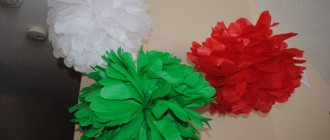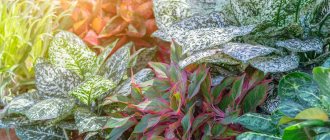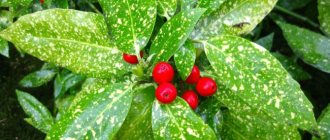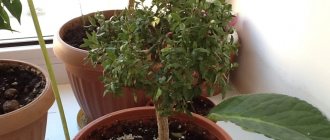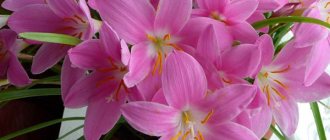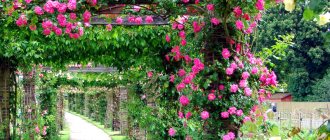Rules for landscaping a children's room
By caring for their green spaces, a child prepares for adulthood and learns to care for all life on Earth.
Having studied biology at school, we all know that plants not only absorb carbon dioxide, but also oxygen. Therefore, landscaping in a children's room should be done in accordance with the age of the child and depending on the area of the room.
Rules
- Until the child is six months old, it is not recommended to place any plants in the room at all, since green pets put an additional burden on the baby’s immune system.
- In the room of a six-month-old child, you can already place the first indoor flowers. You should not grow strong-smelling ones; for example, you should not decorate your room with geraniums. At this age, kids are interested in everything, so each plant should be located in the visibility zone, but out of reach, so that the child can look at the flower, but cannot “taste it for a tooth.”
- At the age of about a year or one year and a couple of months, toddlers are already trying to take their first steps. It is clear that they will want to get to know the flowers better. Therefore, the ideal solution for landscaping a children's room at this age would be hanging flower pots. You can place flowers on shelves located on the wall.
- Ages from 2 to 5 years are characterized by increased activity. The guys are interested in everything and they belong to the “why” category. Green plants will help your baby learn about the world around him.
By caring for his green spaces, a child prepares for adulthood and learns to treat all life on Earth with care.
Parents using the example of the Uzambara violet, aspidistra. geraniums or ficus will be able to explain the process of plant development. In addition, a child can be introduced to work by learning how to care for indoor flowers.
Proper care
Caring for indoor plants in kindergarten includes several stages. Children can also be involved in them.
- Watering is done with water at room temperature, left to sit for 1-2 days. 30-60 minutes after the procedure, the water is poured out of the trays;
- Spraying - carried out with water at room temperature from a fine-grained spray bottle. Helps keep plants fresh and green;
- Washing - to remove dust and dirt, plants that do not have pubescent leaves are periodically washed under a warm shower. The soil in the pot is covered with oilcloth;
- Loosening the soil - done the next day after watering to a depth of 1-1.5 cm;
- Transplantation is carried out when the roots have entwined the entire pot, mainly in the spring. The new pot should be 3-4 cm larger in diameter than the previous one;
- Fertilizing – fertilizing with mineral fertilizers is carried out 2-3 times a month after watering;
- Reproduction - can be carried out in different ways: seeds, cuttings, bulbs, dividing the bush, layering;
- Pest control – the most common dangers are spider mites, scale insects, aphids, and mealybugs. Insects are removed mechanically, after which the plant is washed with soapy water.
The presence of indoor plants in kindergarten allows you to introduce children to nature, teach the basics of caring for green “pets,” curiosity and a caring attitude towards the world around them!
Plants for landscaping and decoration
When choosing plants for a children's room and preschool institutions, first of all you should pay attention to their phytoncidal properties. Such plants are capable of producing biologically active substances that help fight harmful microorganisms and suppress their development.
Plants decorate and benefit
As a result of research, it has been proven that in rooms with plants with phytoncidal properties located in them, there are 50% fewer pathogenic organisms than in similar rooms without flowers.
With the right selection of indoor plants, you can restore the body's defenses and increase immunity in half an hour.
Aspidistra
Aspidistra An unpretentious plant that does not have a dormant period. Lithuania plants are very beautiful and large. Depending on the species, the elongated leaf blades can be painted pure green or may have blotches of a darker tone scattered over the entire surface.
To obtain new specimens, it is necessary to divide the bush of the mother plant. This method is quite simple and does not require any effort. Planted plants quickly adapt to a new location and quickly begin to grow. It is better to propagate in early spring, when the aspidistra begins its period of active growth. A small section with its own root system and several leaves is separated from the mother plant. At first, the potted plant is kept in a warm, humid room.
Aspidistra with green leaves is unpretentious to light levels, soil composition and soil moisture. The variegated plant is more capricious.
It is advisable to grow the variegated form of aspidistra in a well-lit place, since due to insufficient light the pattern on the foliage may disappear!
Geranium
Geranium A beautifully flowering and strong-smelling plant, it is in second place, after Chlorophytum crested, in terms of the presence of beneficial properties that have a phytoncidal effect.
The plant is considered a very powerful air purifier, enriching it with oxygen.
Geranium leaves are used by traditional healers as a remedy for the treatment of colds and runny nose.
However, the strong smell emanating from geranium foliage can cause an allergic reaction in many, so the plant must be grown with caution. Before breeding in a nursery, you need to make sure that the child is not allergic to it.
Hibiscus
Hibiscus An ornamental evergreen plant has recently gained universal popularity due to its gorgeous flowering, even though the flowers on hibiscus last for exactly a day.
The leaf blades are dark green. A common variety in indoor floriculture blooms with red flowers. Thanks to breeding work, many varieties with different flower colors have been developed: yellow, white, orange. There are even specimens with two-color flowers.
When fully bloomed, the flowers look like roses. The plant likes frequent watering and fertilization.
Due to its large size, it is recommended to curb the growth of hibiscus by pruning. However, you need to do this carefully, because every time you shorten the branches of a plant, you can lose its flowering.
For propagation, slightly lignified cuttings are used, which easily take root both in water and immediately in the ground.
Hippeastrum
Hippeastrum An ideal plant for children's rooms and preschools. The vegetative part of the hippeastrum releases substances into the air that have a detrimental effect on bacteria and viruses.
Like no other plant, hippeastrum contains alkaloids - useful substances and compounds that have a positive effect on the nervous system.
Recommended for the owner of the room who tosses and turns for a long time and cannot sleep. Heppeastrum acts on a subconscious level and improves children's sleep. Recommended for hyperactive children.
Fragrant herbs
Fragrant herbs Together with overly active and restless children, it is necessary to grow fragrant herbs. Many pediatricians advise placing a small flowerpot with peppermint, lavender and lemon balm in the room. This composition can be confidently called a living analogue of an aroma lamp.
And when the kids grow up, they can independently pinch off a couple of leaves of healthy fragrant herbs from their garden and add them to tea.
It is necessary to give the child complete independence in caring for his impromptu garden.
A composition of fragrant herbs will fill the air with soothing aromas, create a warm, relaxing atmosphere and cleanse the air of harmful impurities.
And herbs reproduce very easily - by seeds. You can rejuvenate the bushes and plant new plants from time to time.
Kalanchoe
Kalanchoe This is a plant that must be grown in a nursery or in a house where children's voices are heard.
Kalanchoe has powerful phytoncidal properties. By growing a plant on the windowsill, you provide yourself and your family with the necessary medicines that are harmless to the body and have an effective effect on colds and respiratory diseases.
Rubbing a Kalanchoe leaf can cure a runny nose in a matter of days, which cannot be said about the effect of medications that may not achieve the desired effect.
Arabian coffee
Arabian coffee Under natural conditions, the plant reaches 8-10 m in height. Cultivated species cannot please with such rapid growth, but this is not the most important thing, because when grown at home, not every owner will be able to provide it with so much space.
The bark of the small tree is covered with light green, slightly gray bark. Opposite leaves are located on drooping, flexible branches. The leaf blades are attached to the branches by short petioles.
Green coffee leaves purify the air and enrich it with beneficial substances.
Laurel
Laurel Laurel is a small shrub whose branches are densely covered with dark green foliage. When rubbed, the shiny foliage thins out its unique aroma. Flowering is long lasting. It blooms with small flowers with yellow petals.
Under natural conditions it can be found in the Crimea and the Caucasus. The indoor form of laurel reaches a height of 2 m, and in natural growing conditions the tree grows 6 m in height.
Laurel must be grown, as the foliage releases beneficial substances that destroy bacteria.
In addition, the unusual tree has many other advantages. The substances included in the composition and released into the air have a detrimental effect on the tuberculosis bacillus.
The leaves help treat sore throats and inflammation in the mouth, so it’s not even a sin if a child picks a leaf from a tree and chews it a little. This will not affect the baby's health in any way.
In spring and summer, it is preferable to grow laurel on a balcony or terrace. It is advisable to provide him with a flow of fresh air. And laurel propagates very easily - by cuttings.
Lemon tree or citrus garden
Lemon tree or citrus garden You definitely need to plant some kind of citrus tree. And it doesn’t matter whether this tree is a lemon, a tangerine or an orange, the important thing is that it is very useful for children.
Each of the citrus trees contains essential oil, which has bactericidal properties.
And how beautiful the plant is during flowering! In addition, during flowering, the lemon tree thins out such a wonderful aroma and releases substances into the air that have a calming effect on the nervous system.
Therefore, growing citrus trees is recommended in a nursery owned by an overly impulsive and irritable child. Citrus trees help solve the problem of insomnia.
Many parents are dejected that there is a non-flowering tree growing in the room. There's nothing wrong with that. Not only the fruits and flowers of exotic plants emit beneficial substances; the leaves of the plant are also endowed with similar properties.
If at the moment you want to enjoy the aroma of citrus trees, it is recommended to rub a leaf in your hands and feel this captivating aroma.
Myrtle
Myrtle During flowering, myrtle is covered with numerous snow-white flowers. Its flowering has a calming effect on a person and calms the nervous system. That is why it is recommended to grow myrtle in children's institutions.
The aroma of myrtle can relieve daytime fatigue and help the body recover from stressful situations. It is useful for schoolchildren because it relieves fatigue and stress received during classes.
For very restless children and children suffering from insomnia, myrtle helps improve sleep.
Myrtle aroma relieves severe anxiety, has a relaxing effect, and relieves excessive excitement. It helps insecure children (and adults) to get on their feet and feel confident in their abilities.
Fern
Fern Fern is an evergreen plant with interesting leaves, not even leaves, as we usually call them, but with branches with shoots.
It is recommended to grow ferns in those houses whose owners would like to feel more confident in their abilities.
The plant helps protect against stress. By growing a fern, it will help you not waste your time; it will help you plan your day in such a way as to spend it profitably, leaving time for rest.
Necessary for those who are unable to decide what is most important to them. Fern helps to prioritize and highlight the main things, placing emphasis on them.
Chlorophytum crested
Chlorophytum crested The plant is widespread and is found in almost every gardener's home, educational institutions, and kindergartens. Chlorophytum crested is an unpretentious plant that can purify the air 100%. It is used as a natural filter.
Green or green-white elongated leaves of chlorophytum can cleanse the room of harmful impurities. They have an effect on pathogenic bacteria and viruses.
Scientists have found that in children's rooms where chlorophytums are grown, children are much less likely to get colds and flu.
Chrysanthemum
Chrysanthemum A beautiful flowering plant is a necessary element of children's room decor. The plant not only disinfects the air, but also filters air flows well, freeing them from dust and impurities.
It is recommended to grow plants in every home or garden plot, as it is believed that chrysanthemum growing in the house protects the owner from the evil eye.
Usambara violet
Usambara violet
Uzambara violet A lot can be said about violets. Uzambara violet is the queen among all indoor flowers. Thanks to such high popularity and demand, a huge number of varieties have been bred that delight the eye not only with variegated, multi-colored foliage, but also with huge, simple, double flowers. There are also chimera violets.
If the space is limited, you can collect a large collection of mini-violets. If it is not possible to grow plants, you can buy hanging varieties and grow them in a small hanging pot. Anyone who once has a violet in their home will subsequently not be able to refuse to purchase more and more new varieties.
Violet has a beneficial effect on the nervous system, calms and gives peace. The warm tones of flowers soothe, give a positive mood, and cleanse the air of various negativity and dust. Looking at a bouquet of gorgeous flowers, you can admire them for hours.
Ficus
Ficus This plant was one of the first to be studied by botanists for the effect it has on the atmosphere of the house and human health. During the research, it turned out that the beneficial substances released by the plant into the air purify it of harmful impurities, for example, phenol, formaldehyde, benzene, and trichlorethylene.
Ficus leaves contain enzymes that saturate the air with oxygen. Thanks to them, absorbed harmful substances are converted into amino acids and sugar.
Cyclamen
Cyclamen Plant of creative people. It is recommended to place it in a room with an older child, as cyclamen can awaken hidden creative talents in a child.
The plant helps to find a common language and has a unifying effect, therefore it is recommended for growing in kindergartens and in groups of children.
In addition, children's institutions practice planting chlorophytum curica and cyclamen - two plants that are grown in tandem. As a result of decorating a room with these flowers, the air in the room is noticeably purified and children's creative abilities are revealed, which can be revealed in the process of collective work.
Whatever plants parents choose to decorate the children's room, you must first find out their beneficial properties that they have on children and think about how this or that plant will be useful for the child. In children's institutions, it is recommended to grow plants that are considered safe for children and are approved for growing in institutions.
Flowers for kindergarten
The child spends most of the day in kindergarten.
Therefore, it is natural that parents want it to be cozy and comfortable there, just like at home. Indoor plants can help with this. In addition to aesthetic pleasure, flowers in kindergarten also bring practical benefits . They perfectly clean the air of dust and toxic substances. The phytoncides that some green “pets” secrete have bactericidal properties.
Scientists have proven that in a room where there are indoor plants, the number of harmful microorganisms is halved. Plants increase the level of air humidity, which is especially important during the heating season.
In addition, representatives of indoor flora have a positive effect on the mental and emotional health of children, bring joy, and relieve fatigue. It’s also an opportunity to get acquainted with the world around us, learn how to care for plants, and develop responsibility and kindness.
However, despite all the advantages of having indoor flowers in a kindergarten, not every one of them is suitable for this institution.
Plants that should not be grown in a child's room
The appearance of some plants can cause fear in a child
In addition to useful plants, there are many other decorative and beautifully flowering indoor flowers that are prohibited from growing in rooms where children are present. And they are considered prohibited due to their dangerous substances found in the foliage of the potted flowers themselves. By breaking off a leaf of such a plant and chewing it, you can get poisoning or an unwanted allergic reaction that will appear on the child’s skin in the form of rashes.
Poisonous plants
All kids love to learn new things, they are interested in: what, how and why. Some plant leaves contain poisonous sap, which can cause serious poisoning and allergic reactions.
List of poisonous plants:
- nightshade - after flowering, huge, attractive berries are formed in place of the bolls, which are poisonous to humans
- alocasia – the leaves contain hydrocyanic acid and alkaloids
- oleander is a beautifully flowering plant characterized by the fact that all vegetative parts contain juice that is poisonous to humans
The above plants are not recommended to be grown in children's premises, as well as:
Dieffenbachia
Bush and tall species of Dieffenbachia cannot be grown not only in nurseries, but also in preschool educational institutions
Dieffenbachia is considered the most poisonous indoor flower, since the juice of the leaves is very poisonous. In ancient times, slaves were forced to chew Dieffenbachia leaves in order to make their voices disappear and they could not say anything.
The poisonous juice gets on the skin and causes a severe burning sensation. And if the child also rubs his eyes with his hand, it will be impossible to do without medical help.
Plants that can injure children
If tall species of sansevieria are prohibited for cultivation in children's rooms and in children's institutions, it is recommended to pay attention to low-growing varieties, for example, the sansevieria variety Honey
Many people like the inhabitants of dry areas - cacti and succulents. If for an adult these are wonderful plants that do not require close care, then for children they can cause great harm, since they have sharp thorns.
In addition to cacti, you should be careful when growing plants with long leaves, such as sansevieria or mother-in-law's tongue. This is undoubtedly a useful plant, but long leaves can play a cruel joke. The fact is that a child, crawling around the house, can stand on his feet and reach a plant standing on the table, pull a beautiful long leaf and throw a large pot onto himself from the table. To avoid injury, you should not grow the plant in your baby’s room, especially since the leaf is very sharp and can cause injury.
Plants that cause fear
Sundew is a “scary” plant for children. God forbid a child sees it swallowing an insect. The baby will have an insurmountable fear that someday this plant will bite him too.
It's no secret that childhood is a time of all sorts of imagination and imagination. Therefore, you need to be extremely careful when choosing plants. You can buy a completely harmless plant that only brings health benefits, but it will have intricate foliage that can frighten a child.
It is not recommended to buy tall palm trees and vines for the children's room. These include: monstera, dracaena, scindapsus, philodendron. The named flowers, after they grow, on a sunny day can cast terrible shadows in which children can see, thanks to their imagination, terrible monsters and monsters.
Plants that cause allergies
It is believed that hydrangea with exotic flower colors can cause allergies. However, before throwing this flower away, you need to check whether this is actually the case. After all, not all people have a plant that can cause a similar reaction.
Indoor potted flowers that cause irritation to the mucous membranes and skin:
- hydrangea
- azalea
- pelargonium
Having named the list of plants prohibited for cultivation due to the fact that they cause allergic reactions, it is necessary to make a reservation that these plants are beneficial to health, therefore, before throwing them aside, it is recommended to check whether you are allergic to them or not. If there are no signs, the plants can be grown.
But azalea is considered a poisonous plant, the juice of which can cause severe allergies. Therefore the flower is not recommended.
The world of flowers is a wonderful world that not only helps to purify the air and improve the atmosphere at home, thanks to the beauty and variety of potted flowers, you can introduce a child to the world of beauty, show how plants live, grow and reproduce, and teach a child to work. By caring for plants, kids acquire the skills of responsibility for all life on Earth. They learn that everything needs care and that only work and perseverance will help preserve the beauty of the living world.
Card file for studying indoor plants by age
Anya Popova
Card file for studying indoor plants by age
Junior preschool age.
Show how indoor plants grow. Give an idea that plants need soil, water and air to grow.
Kids should learn to recognize and name 2–3 plants and their main parts (leaf, stem, flower). Children are involved in caring for plants (watering with water prepared by adults, wiping large leathery leaves of plants with a damp cloth). In a corner of nature, plants are placed that have clearly defined main parts of the stem, leaves that are brightly abundant and bloom for a long time.
1. Uzumbara violet.
Middle preschool age.
Strengthen children's knowledge about herbaceous and indoor plants. Learn how to care for them.
Indoor plants should have different shapes and sizes of leaves, as the children master new techniques for keeping plants clean: they pour a fine-mesh watering can on or spray plants with small leaves from a spray bottle, wipe jagged leaves with a damp brush or brush, and drooping leaves with a dry brush. At the same time, there can be up to 6 – 8 species of plants in a corner of nature.
Senior preschool age.
Continue to introduce indoor plants. Learn to care for plants. Talk about methods of vegetative propagation of plants.
Children should know that plants need light, moisture, warmth, and soil nutrition to grow: different plants need different amounts of light and humidity.
1. Tradescantia (2-3 species).
2. indoor grapes.
3. climbing ivy.
Preparatory age for school.
Concretize children's ideas about the living conditions of indoor plants. Introduce them to methods of vegetative propagation (cuttings, leaves, tendrils). Continue to teach children to establish connections between the state of the plant and environmental conditions. Expand your understanding of medicinal plants (plantain, nettle, etc.).
3. Uzambara violets.
PASSPORT FOR HOUSE PLANTS IN PRESENTATION.
Attached files:
Photo report “The World of Indoor Plants” GOAL: To clarify and systematize children’s knowledge about indoor plants.
OBJECTIVES: * teach children to more fully describe indoor plants. Pin. Conversation at an exhibition of indoor plants Program content: - expand children's ideas about indoor plants: their benefits and structure. -introduce the variety of indoor rooms. Card index of indoor plants, care, watering and propagation FICUS Temperature: preferably moderate, not lower than 18 ° C. Lighting: All varieties of rubber ficus prefer a bright place.
Card index of indoor plants in the FICUS kindergarten Temperature: preferably moderate, not lower than 18 ° C. Lighting: All varieties of ficus rubber prefer light.
Card index of riddles by age Shaggy, Mustachioed, Drinks milk, Sings songs. (Cat) Small stature, long tail, Gray coat, sharp teeth (Mouse) Who.
Project “Mini-museum “The World of Indoor Plants” Contents of the project Project name: Mini-museum “The World of Indoor Plants”. Type of project: educational - creative. By duration:.
Mini-museum project “The World of Indoor Plants” Contents of the project Project name: Mini-museum “The World of Indoor Plants”. Type of project: educational - creative. By duration:.
Preview:
Consultation for educators
"Indoor plants in a corner of nature for every age group"
MDOU Child Development Center
“Indoor plants in a corner of nature for every age group. Selection and care of them"
Introducing children to nature in kindergarten requires constant, direct contact with it. One of the conditions that ensures this is the organization of nature corners in kindergarten. Each age group has its own corner of nature. Permanent inhabitants of the corners of nature in the kindergarten are indoor plants. They have been decorating human homes for a long time. Some of them bloom profusely and for a long time, others have beautiful foliage. Most plants come from tropical and subtropical countries: hot deserts and savannas, tropical rainforests and swamps. Indoor plants of different care (different soil, watering, degree of illumination, etc.). Indoor plants are valuable teaching material; they are obligatory inhabitants of a corner of nature.
Placing indoor plants.
Firstly, the plants must be positioned so that it is convenient for both adults and children to approach them. There are no more than two plants on the windowsills. Houseplants, in relation to light intensity, are divided into light-loving and shade-loving. Most plants are photophilous and develop better in strong light. Light-loving plants are those that grow in high, intense light (geranium, cacti, abutilon, fuchsia, gloxinia). It is better to keep them on or near a window.
Shade-tolerant plants can grow in light and light shade (asparagus, aloe, sansevieria, monstera). Shade-loving plants: aspidistra, begonias, clivia, ferns, tradiscantia. They grow well on windows facing north and west. When there is an excess of light, their leaves become lighter due to the reduction of chlorophyll grains in the cells. In dark places, shade-loving plants acquire a dense green color. In bright groups, rooms with windows facing south, east, west, many indoor plants can be successfully grown. Some plants are especially sensitive (geranium, fuchsia) to changes in position relative to the light source. Therefore, after a plant has been assigned a permanent place in the group, it should be spared from rearrangements. If you look at green plants, you can see that they all reach for the light and turn towards it, so in groups they often take on a somewhat one-sided shape. To prevent this from happening, it is recommended to gradually turn towards the light, then they will grow evenly in all directions (this applies to the following plants: ficus, aspidistra, ferns, etc.)
But it is better not to turn over beautifully flowering plants such as geranium, fuchsia and begonias, then the branches facing the sun will bloom profusely and luxuriantly. When the flowers bloom, only then can the flowering side be turned into a group. Beautifully flowering plants are especially demanding of light, since in order for the flowers to bloom, the buds must be illuminated by direct sunlight. In summer, plants need protection from direct sunlight, especially (royal begonia, glaxinia). It is necessary to shade the plants from direct sunlight. So, if you place asparagus in a window brightly lit by the sun in summer, its cladonia will turn yellow and fall off.
In winter, it is also necessary to protect plants sleeping on the window. Use thin cardboard and thick paper. Ventilation is necessary for indoor plants to ensure an influx of fresh air, and open not only the vents, but also the windows, if the weather permits, of course. Indoor plants are very sensitive to the direct action of cold air, so keep the doors closed when ventilating.
Selection of plants in a corner of nature and caring for them.
When selecting plants for a corner of nature, you should take into account the requirements imposed by the “Kindergarten Education Program”.
What are these requirements?
- Plant care should be accessible to preschool age (with the participation and guidance of the teacher). Therefore, unpretentious plants are selected.
- The plants in the corner should be visually attractive, capable of attracting and retaining the not-so-steady attention of preschoolers.
- It is necessary to have several copies of the same plant species in order for children to see not only general, but also individual characteristics; this leads them to understand the diversity and uniqueness of living organisms.
- Plants must be safe and not harmful to the health of children.
Kids should learn to recognize and name 2–3 plants and their main parts (leaf, stem, flower). Children are involved in caring for plants (watering with water prepared by adults, wiping large leathery leaves of plants with a damp cloth). In a corner of nature, plants are placed that have clearly defined main parts of the stem, leaves that are brightly abundant and bloom for a long time. These are ordinary or zonal geranium, ever-blooming begonia, balsam, aspidistra, ficus, violets and so on.
Children's attention is also attracted by plants with variegated leaves - aucuba, coleus. Aucuba has fairly large and strong leaves, which can be used to teach children of the second youngest group the first small techniques of keeping plants clean.
Of these species, 3–4 plants are introduced for observation throughout the year. Some of them should be in duplicate, so that children can learn to find identical plants.
Knowledge about plants becomes more complex. Children more clearly distinguish the characteristics of plants and become familiar with the conditions necessary for their life. The number of plants they recognize increases. Indoor plants should have different shapes and sizes of leaves, as the children master new techniques for keeping plants clean: they pour a fine-mesh watering can on or spray plants with small leaves from a spray bottle, wipe jagged leaves with a damp brush or brush, and drooping leaves with a dry brush. In addition to the plants of the younger group, aloe or asparagus or agave are placed in the middle group, begonia - less often, fragrant geranium. At the same time, there can be up to 6 – 8 species of plants in a corner of nature.
Children should know that plants need light, moisture, warmth, and soil nutrition to grow: different plants need different amounts of light and humidity. The ability to determine the method of caring for plants depending on the nature of the leaves and stem (the method of keeping plants clean) is consolidated. Includes knowledge about some methods of their vegetative propagation, in particular by stem cuttings. All this requires replenishing the corner of nature with new plants: with a variety of climbing stems, creeping ones, having bulbs, corms. These can be 2-3 types of tradescantia, indoor grapes, climbing ivy, ficus, aloe, epiphylium, clivia.
The main task of introducing nature in the preparatory group is to develop basic knowledge about the significant dependence of plants on a set of conditions (moisture, heat, light), so that children learn how to water various plants depending on their living conditions in their natural environment. In a corner of nature, you should place plants that differ sharply in their moisture needs: cyperus, which grows in very moist soil for 10 months of the year. Cacti (1 - 2 species) that require very little and sharp watering, Tradescantia with a high need for moisture, Usambara violets, which should be watered very moderately. Many subtropical plants that are at relative rest in their homeland at this time - geraniums, fuchsias and others - need moderate watering in winter. Depending on the conditions of growth and development of plants located in a corner of nature and the conditions of their origin, one must remember when caring for other plants, especially from the lily and amaryllis families - amaryllia, clivia, dracaena. The first period of winter for these plants is a dormant period; at this time they almost stop watering. The so-called viviparous plants are of great interest to children: saxifrage, chlorophytum. All of them have offspring that do not grow from a rhizome hidden in the ground, but appear from other parts of the plant, the tendril of saxifrage, the flower shoot of chlorophytum, and so on.




